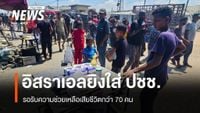On July 20, 2025, the skies over Gaza were illuminated by a series of fiery explosions, marking a grim chapter in the ongoing conflict that has devastated the region. As dawn broke, at least three more loud blasts echoed through the air, followed by plumes of smoke rising ominously above the city of Deir al-Balah in central Gaza. This was not just another day of violence; it was a day that laid bare the escalating humanitarian crisis gripping the Gaza Strip.
Thousands of Gazans flocked to an aid distribution center in northern Gaza, desperate for relief supplies amid worsening shortages. Many returned clutching sacks of flour, a stark symbol of their struggle to stave off hunger. One resident, acknowledging the risks, expressed a sentiment shared by many: "We know it's dangerous, but we have to come because the situation is so difficult, and the whole world is just watching." This plea for help underscores the desperation felt by civilians caught in the crossfire.
The Gaza Health Ministry, controlled by Hamas, reported a harrowing toll: at least 67 Palestinians were killed while waiting for United Nations aid trucks in northern Gaza after Israeli forces opened fire. This grim statistic aligns with accounts from the World Food Programme (WFP), which stated that 25 aid trucks entering Gaza recently encountered large, hungry crowds that were subsequently shot at. The WFP condemned the violence, calling it "utterly unacceptable," and highlighted the skyrocketing malnutrition rates, with 90,000 women and children urgently needing treatment. Nearly one in three people in Gaza have gone without food for days, painting a dire picture of a population on the brink.
Israel’s military, the Israel Defense Forces (IDF), responded by saying they fired warning shots to disperse what they described as "urgent threats" from the crowds. The IDF challenged the reported death toll as exaggerated and denied any intentional targeting of humanitarian aid convoys. Nevertheless, the reality on the ground was stark: in addition to those killed near aid centers in northern Gaza, six others died waiting for assistance elsewhere, and over 150 people were wounded. The Gaza civilian protection agency tallied a total of 93 deaths and dozens of injuries across Gaza on that day alone.
The humanitarian crisis deepened further when the Gaza Health Ministry issued a dire warning on July 19, 2025, about the rapidly escalating hunger crisis. Hundreds of emaciated individuals were at risk of dying soon due to starvation, with increasing numbers arriving at hospitals in severely weakened conditions. In the 24 hours leading up to July 21, 18 people succumbed to starvation. Hospitals like Shifa in Gaza City, under the direction of Dr. Hassan Al-Shaer, have been overwhelmed by the influx of injured and malnourished patients, struggling to cope amidst limited resources.
Compounding the crisis, Israel ordered the evacuation of residents from central Gaza, particularly in Deir al-Balah, directing them to move towards al-Mawasi on the Mediterranean coast. This directive sparked panic among tens of thousands of Palestinians and raised alarm among families of Israeli hostages believed to be held within Gaza. After 21 months of war, the Israeli army has conducted numerous airstrikes in these areas but has yet to initiate a ground invasion. According to a Reuters report citing Israeli military sources, the hesitation to enter these zones is due to Hamas holding an estimated 50 hostages, at least 20 of whom are believed to be alive.
That night, multiple explosions rocked Deir al-Balah, underscoring the volatile and dangerous environment. The ongoing conflict continues amid stalled negotiations for a 60-day ceasefire between Israel and Hamas, with no signs of progress. A Hamas official conveyed to Reuters the group’s anger over the rising death toll and worsening hunger crisis, warning that these factors could severely undermine the fragile ceasefire talks currently underway in Qatar.
The violence against civilians seeking aid is not new. Since late April, reports have emerged almost daily of Palestinians being killed while waiting for food assistance. On July 19 alone, at least 32 people were shot dead near two aid distribution points in southern Gaza, near the cities of Rafah and Khan Younis. These locations are critical hubs for humanitarian efforts, including those run by the Gaza Humanitarian Fund (GHF), which receives support from the United States and Israel. The GHF employs private security contractors to manage aid distribution in Israeli military zones, yet even these areas have not been spared from violence.
The World Food Programme’s condemnation of the attacks highlights a broader international concern. Their statement on social media emphasized the skyrocketing rates of malnutrition and the urgent need for medical treatment, especially for women and children. The situation is a stark reminder of the human cost of the conflict, beyond the immediate casualties of war.
As the humanitarian situation deteriorates, the international community faces mounting pressure to intervene effectively. The images of smoke rising over Gaza, the stories of families risking their lives to reach aid centers, and the mounting death toll from starvation and violence paint a bleak picture. Yet, amidst this turmoil, there is a palpable sense of urgency and a call for action to prevent further loss of life.
The unfolding events in Gaza reflect a complex and tragic chapter in a long-standing conflict. The interplay of military actions, humanitarian crises, and fragile ceasefire negotiations creates a volatile mix with profound implications for the region’s future. As the world watches, the people of Gaza continue to endure unimaginable hardships, caught between the crosshairs of war and the desperate need for survival.




